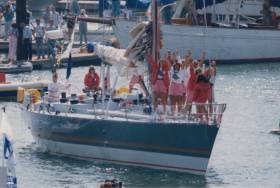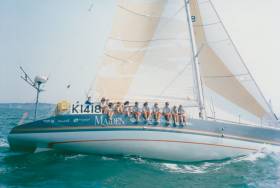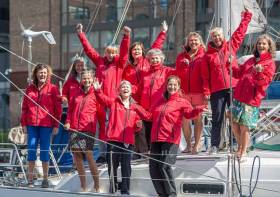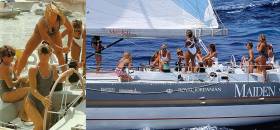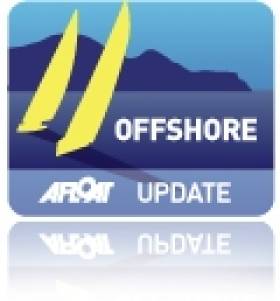Displaying items by tag: Tracy Edwards
Tracy Edwards’ Maiden Confirmed for Ocean Globe Race
Tracy Edwards MBE and DP World, title sponsor of The Maiden Factor World Tour, have announced that the iconic yacht Maiden and her all-female crew will enter the 2023 Ocean Global Race.
The news confirms the commitment Edwards made in 2019 when the event was announced as a tribute to mark the 50th anniversary of the first Whitbread Round the World Race in 1973.
Maiden will take a break from her world tour, which began in September 2021, to take part in the race which sets out from a European port on 10 September, just 200 days away.
Edwards and crew have covered nearly 30,000 nautical miles visiting 20 destinations and engaging with schools, charities and organisations as part of her mission to educate, empower and elevate girls, increasing their life and career choices and also raising money to fund girls’ educational projects around the world.
And she believes the OGR will provide a great opportunity to amplify Maiden’s mission and the importance of educating all girls for better futures for all.
Maiden is currently in Cape Town, South Africa and will sail back to the UK for final preparations for the September start, once again with a young female skipper and crew of up-and-coming sailors from around the world, who will no doubt inspire another generation of women and girls to follow their dreams.
In 1989 Edwards made history as the skipper of the first ever all-female crew — among them Irish sailor Angela Farrell — to enter the Whitbread Round the World Race, now The Ocean Race. Their achievement is celebrated in the 2019 documentary Maiden.
The yacht later changed hands several times and her whereabouts were lost until 2014, when Edwards tracked her down to an island in the Indian Ocean. Despite being in serious disrepair, Maiden was eventually restored to her former racing glory.
Tracy Edwards Welcomes All Female Yacht Maiden That Sails into New York on Empowerment Mission
Iconic vintage yacht Maiden sailed into New York on Wednesday, 1 June and was met by a flotilla of boats at the iconic Statue of Liberty at around 1700hrs and escorted in to One 15 Brooklyn Marina.
In New York for the month of June, Maiden will be host to visits by children from schools, various girls’ organisations and charities; the crew will also participate in STEM events with sailing clubs and there will also be boat tours, fundraising events as well as a screening of the award-winning documentary ‘Maiden’ to be held at Pier 17, South Street Seaport Museum on 13 June 2022.
 Mission founder and 1989 round the world yachtswoman Tracy Edwards in New York Photo: Bjoern Kils
Mission founder and 1989 round the world yachtswoman Tracy Edwards in New York Photo: Bjoern Kils
Maiden’s mission is to work with, raise funds for and support communities to enable girls into education and empower and support them to remain through their teenage years to reach their full potential and create better futures
Maiden has become a Global Ambassador for the Empowerment of Girls through Education.
Mission founder and 1989 round the world yachtswoman Tracy Edwards was on hand to meet the boat's arrival in Brooklyn. The British MBE was in Dun Laoghaire Harbour for an evening in late May at the Royal Irish Yacht Club as Afloat reported here.
Tracy Edwards Evening at Royal Irish Yacht Club is Postponed
Due to personal reasons, round the world sailor, Tracy Edwards MBE will not be able to attend Royal Irish Yacht Club (RIYC) at Dun Laoghaire for her talk scheduled for Wednesday, March 23rd.
As Afloat previously reported Edwards skippered her yacht Maiden, the first all-female crew, in the Whitbread Round the World Yacht Race in 1989, achieving second overall in Class and becoming the first woman to receive the Yachtsman of the Year Trophy.
The event will be rescheduled, according to a RIYC statement.
, the event will be re-schedule for a later date.
An Evening with Tracy Edwards MBE at Royal Irish Yacht Club in Dun Laoghaire Harbour
The Royal Irish Yacht Club in Dun Laoghaire Harbour will host 'An Evening with Tracy Edwards MBE' on Wednesday, 23rd March
In 1989 Edwards skippered Maiden, the first all-female crew, in the Whitbread Round the World Yacht Race, achieving second overall in Class and becoming the first woman to receive the Yachtsman of the Year Trophy.
She will deliver a talk that will take members and guests from the original Maiden Project through to the Maiden Factor, a global foundation that inspires women and girls all over the world.
The talk commences 1900 hrs.
Tracy Edwards Documentary Set For Special Q&A Screening At Dublin’s IFI
The Irish Film Institute in Dublin joins the list of locations for a special screening of Alex Holmes’ Tracy Edwards documentary Maiden on Thursday 7 March.
As previously reported on Afloat.ie, Cork’s Gate Cinemas will also host the preview followed by a satellite link Q&A with Tracy Edwards and some special guests.
Edwards made history as the skipper of the first ever all-female crew to enter the Whitbread Round the World Race, which became the Volvo Ocean Race and is now simply The Ocean Race after its recent change of ownership.
Maiden opens at the IFI on Friday 8 March. Tickets are available for the special preview from 6pm on Thursday 7 March from the IFI box office.
Tracy Edwards Documentary To Have ‘Maiden’ Screening In Cork Next Month
Cork’s Gate Cinemas will stage a special screening of the new Tracy Edwards documentary Maiden, followed by a satellite link Q&A with Edwards herself, on Thursday 7 March.
Edwards was a 24-year-old cook on charter boats when in 1989 she became the skipper of the first ever all-female crew to enter the Whitbread Round the World Race, the precursor to the Volvo Ocean Race.
Maiden charts Edwards’ struggle against the odds — facing chauvinism in the yachting community, and rejection from sponsors — to put a team on the water.
Sailing a second-hand yacht financed by remortgaging her home, Edwards and her crew showed the world that women sailors were capable of doing everything their male counterparts could.
And their legacy can be seen more recently both in the all-woman Team SCA in the 2014-15 VOR, and the most recent edition that encouraged mixed crews. Indeed, Olympians Carolijn Brouwer and Marie Riou were part of the crew on the race-winning Dongfeng Race Team.
Maiden opens on Friday 8 March but tickets go on sale today (Friday 1 February) for the special preview screening in Cork the night before. Tickets go on sale today with details to follow.
Yachtswoman, Tracy Edwards MBE, is reuniting her legendary ‘Maiden’ crew for the first time since 1990 when they became the first all-female team to sail around the world and into the record books. Th crew includes Dun Laoghaire sailor Angela Heath (neé Farrell) from the Royal St. George Yacht Club.
The crew gained acclaim for their successes in the Whitbread Round The World Race in 1989-90, where they defied expectations and shattered glass ceilings; setting the best result for a British boat since 1977, which has remained unbeaten to this day. Their incredible story is currently being turned into a new documentary, produced by New Black Films. In honour of their reunion, the renowned sailors were treated to a private screening preview of the film currently in production, among family and friends at BAFTA in London.
A story about guts, courage and determination, the documentary is set to chronicle the team’s 167-day, 32,018-mile journey around the globe, where they overcame icebergs, a tornado and five days without food. Their achievement shattered stereotypes, broke records and paved the way for women in sport and beyond. Tracy Edwards MBE, Maiden’s Skipper, said:“Today, for the first time since the end of the Whitbread, the Maiden crew are reunited. We spent nine months together during the race and shared a truly unique experience and bond. It has been wonderful to get back together and share our stories and enjoy watching a preview of the forthcoming documentary. “Back in 1989 many people did not believe that a group of women sailors could take on such a notorious challenge, and many wrote off our chances. We not only completed the race but did so in an impressive time, coming second in our class, ahead of many all-male crews.
Our accomplishment reached beyond the world of sailing –showing that with the right support and plenty of belief, women can do anything. Over the past 30 years, the opportunities available to women have been evolving for the better. However, there is still so much to be done. Thanks to the generous support of HRH Princess Haya’s global initiative: ‘Anything is Possible’, which supports and inspires the best in people, Maiden will set sail again this September, promoting and campaigning for educational equality across the globe.
We hope the next chapter in Maiden’s story will inspire and empower a new generation of young girls to fulfil their dreams and reach their potential.” Maiden will set sail later this year from Southampton to Jordan on the first leg of her three-year world tour raising awareness for girls’ education
Iconic 'Maiden' Voyage Sails Again As Round-The-World Yachtswoman Renews Partnership With Jordan
Initially conceived 30 years ago, the Hashemite Kingdom of Jordan has renewed its partnership with round-the-world yachtswoman Tracy Edwards and her iconic boat Maiden. In 1990, Edwards made the history books by leading the first all-female crew to the finish line of the Whitbread Round the World Race (now the Volvo Ocean Race) with Maiden as the star of the show proudly displaying the royal crown of the Jordanian family on her sail.
In 2017 Maiden will be restored to her former glory, Jordanian colours and all, and will embark on a new worthy venture to carry on the legacy started in the 1980s by Ms Edwards, with the support of His Majesty King Hussein of Jordan. A pioneer of the times, His Majesty King Hussein believed in Edwards’ vision for a truly empowering female-only crew to sail around the world, breaking preconceptions and records at the same time.
Already 8 years old by the time of the race, Maiden and her 12-strong crew helped to inspire women to take up sailing and challenge the perception of what women were capable of, by winning two legs of the race and coming second overall in her class.
The yacht was recently discovered by Edwards, falling into disrepair in the Indian Ocean, and the Jordan Tourism Board has been a key advocate for ensuring this iconic boat is restored to her former glory and used as a vessel for inspiration and innovation.
Through a combination of crowdfunding and sponsorship, Maiden will undergo a huge restoration over the coming months. Maiden will then have a new purpose with The Maiden Factor, a not-for profit organisation which will work with charities such as I am Girl, Just a Drop, Girl Up and The Girl’s Network. Maiden as an Ambassador for The Maiden Factor will sail the globe promoting the agenda of education for girls and raise funds for these associated charities as well as Maiden Education.
Filming has begun for a one-off TV series which will follow the rescue and restoration of Maiden and also the selection and training of a new crew. The original Maiden crew from 1989/90 will deliver the grand dame of sailing to London in September 2017 for her re-launch. Celebrations will include sailing under Tower Bridge and handing Maiden over to her new crew. Crew trials will test sailing skills on the water in the UK and in Jordan the stamina and teamwork of the hopefuls will be tested along the magnificent Jordan Trail which stretches 650 km from Um Quais in the north of Jordan to Aqaba in the south.
Filming is already underway to accompany a documentary about Maiden’s completion of the 1989/90 Whitbread Round the World Race, which will be aired on prime-time television and have a premiere in Leicester Square in time for Maiden’s triumphant reveal in London in summer 2017. Following her London film premiere Maiden will attend the start of the 2017/18 Volvo Ocean Race in Alicante after which she will sail to Jordan for the winter.
Of the project Tracy Edwards MBE said, “Maiden is an inspiration and I want her to engage with people all over the world. She is an icon of female empowerment, the ability and will to succeed against all odds and that’s something I want to harness and use to inspire young girls everywhere to achieve their full potential. We must ensure that the basic human right of every girl is to have an education, a conviction shared by His Majesty King Hussein of Jordan, who was the first person help me on my initial quest to get an all-female crew to sail around the world. It would be an understatement to say that I was delighted that the Kingdom of Jordan under the reign of his son, His Majesty King Abdullah II of Jordan, has stepped in to help me on my new mission to inspire a whole new generation and make Maiden a vessel for peace and education across the world.”
Dr. Abed Al Razzaq Arabiyat, managing director of the Jordan Tourism Board said, “When Tracy Edwards MBE told us of her new mission we were only too delighted to help. She has helped to inspire so many people and her new vision is something that aligns perfectly with our own in Jordan. Empowering women, championing girl’s education and inspiring a generation is such a powerful message; it is an honour to be involved in her project and we look forward to welcoming Maiden and her inspirational crew to Jordan in 2017.
Edwards In Bid To Save Whitbread Winner 'Maiden'
#Offshore - Tracy Edwards - who led an all-woman team to victory 24 years ago in the precursor to the Volvo Ocean Race - has launched a bid to recover her race-winning boat Maiden after it was discovered in serious disrepair on an island in the Indian Ocean.
The 58ft offshore racing yacht was already 21 years old when Edwards and crew - including Irish sailor Angela Farrell - sailed her ahead of the pack in the 1990 Whitbread Round the World Race.
But since that time Maiden changed hands between successive owners and her whereabouts were lost.
Now Mail Online reports that Edwards has located Maiden abandoned in the mid-ocean island marina, she intends to return her to British waters for restoration.
But first she needs to raise £50,000 (€62,655) to lift and transport her from the Indian Ocean, and she's already bagged support from big names such as transatlantic record-breaker Richard Branson and Fastnet Race veteran Simon Le Bon of Duran Duran.
Mail Online has more on the story HERE.


























